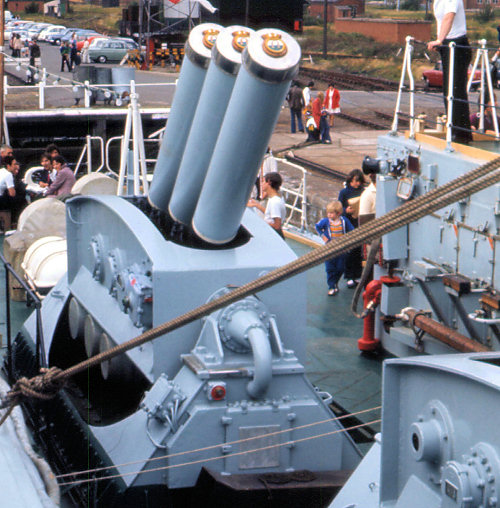|
This is a basic list of the ASW
and torpedo weapon systems used by the Canadian Navy since the 1930s.
The different sources
upon which this page is based sometimes have
conflicting information and details, and some of the information seen
here has therefore been extrapolated from those conflicting sources.
The information provided herein is not intended to be a detailed
technical resource, but rather an inventory and identification aid for
gun systems used by the Canadian Navy.
This page includes a fair bit of guesswork, and corrections will be
welcomed!
Standard Depth Charges & Delivery
Systems
|
|
|
Stern
Rail (for Depth Charges)
|
Fitted to
|
Flower, Revised Flower, and Castle class
corvettes, River class frigates, River, Tribal, V, and C class
destroyers, trawlers, Fairmiles, etc.
|
|
Role
|
Depth charge rail
|
Range
|
N/A, charges dropped in ship's wake.
|
Ammunition
|
Mk.VII and VII Heavy depth charges |
Design Date
|
??
|
Approximate Cdn. Service Dates
|
1939-1945
|
Comments
|
Stern rails were fitted to most or all
RCN ships engaged in ASW during the Second World War. The later Castle
class corvette was built with only a small rail offset to starboard, as
the new Squid mortar largely superseded use of the rails. Ships often
mounted smoke generators on the rails, as seen below in the photos of
SACKVILLE.
Early corvettes often had minesweeping gear fitted (see photo 6) and
this limited the number of charges that could be carried at the stern.
Later corvettes had more room for rails and storage (see photo 5 with
the hoists for reloading) and frigates had even more elaborate rails
and storage (see photo 4).
|
Sources
|
Naval
Weapons of the World website.
Macpherson, Ken and Milner, Marc. (1993). Corvettes of the Royal
Canadian
Navy 1939-1945. Vanwell Publishing Ltd. St. Catherines, ON.
Canadian
War Museum
|
Photos 1-6: © Sandy McClearn
|
1. On SACKVILLE.
|
2. On SACKVILLE. |
3. On SACKVILLE. |
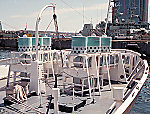
|
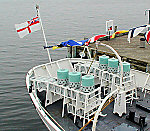
|

|
4.
Frigate model at CWM.
|
5.
Late war corvette model at CWM.
|
6.
Early corvette model at CWM.
|
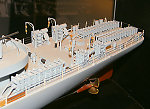
|

|
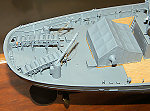
|
|
|
DC
Throwers
Mk.II and Mk.IV
|
Fitted to
|
BANGOR and ALGERINE class minesweepers,
Flower, Improved Flower, and CASTLE class corvettes, River class
frigates, River, Town, and Tribal class destroyers.
|
|
Role
|
Depth charge thrower
|
Barrels / Projectiles
|
1 each
|
Range
|
40 yards for Mk.II with Type D DC, 67 and
51 yards respectively for Mk.VII and Mk.VII Heavy DCs.
|
Ammunition
|
Mk.VII and Mk.VII Heavy depth charges
|
Design Date
|
1916 for Mk.II; ~1940 for Mk.IV
|
Approximate Cdn. Service Dates
|
1939 - 1950?
|
Comments
|
The Mk.II launcher was designed during
the First World War, and remained largely unchanged at the outbreak of
the Second World War. This launcher fired the depth charge, complete
with its cradle, at 90 degrees to the ship's course. Mk.IV launchers
retained the depth charge cradle, making it easier to load the next
charge. These latter launchers were reserved for destroyers, frigates,
and Castle class corvettes in Canadian service. These launchers were
modified for use with light ASW torpedoes postwar on ST. LAURENT and
similar destroyers, as noted below.
Photo 2 below shows the depth charge cradles stored on deck next to the
launcher.
|
Sources
|
Naval
Weapons of the World website.
Gough, Barry M. (2001). HMCS
HAIDA - Battle Ensign Flying. Vanwell Publishing Ltd. St.
Catharines, ON.
Macpherson, Ken and Milner, Marc. (1993). Corvettes of the Royal
Canadian
Navy 1939-1945. Vanwell Publishing Ltd. St. Catherines, ON.
Canadian
War Museum
|
Photos 1&3: © Sandy
McClearn
Photo 2: © Rolie Leduc
Photo 4&5: ©
DND / CWM.
Photos 6&7: ©
Charles Sadler, courtesy of John Sadler
|
1. Mk.II on SACKVILLE.
|
2. Mk.II on SHERBROOKE.
|
3. Mk.II on SACKVILLE. |
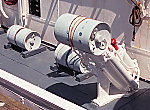
|
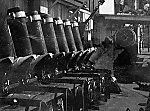
|
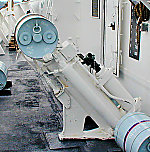
|
4.
Loading a charge on the thrower.
|
5.
Firing a Mk.II launcher.
|
6.
Thower and charge on JOLIETTE.
|
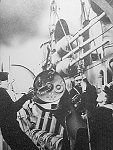
|
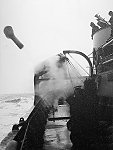
|
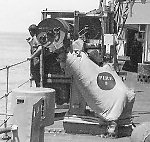
|
7.
On JOLIETTE (River class).
|
8.
|
9.
|

|
|
|
|
|
Depth
Charge Mk.VII and Mk.VII Heavy
|
Fitted to
|
Trawlers, Fairmiles, Minesweepers,
Corvettes, Frigates, Destroyers.
|
|
Role
|
ASW depth charges
|
Launcher
|
Mk.II or Mk.IV depth charges throwers,
stern rails.
|
Range
|
Effective to 300 foot and later 500 foot
depths.
|
Warhead
|
290 lbs. TNT with hydrostatic fuse.
|
Design Date
|
??
|
Approximate Cdn. Service Dates
|
1939 - 1945?
|
Comments
|
Standard depth charges in Canadian
service during the Second World War. The Heavy charge had an extra
weight attached to increase the sink rate. The author is uncertain if
the Heavy charge was actually used in Canadian service.
|
Sources
|
Naval
Weapons of the World website.
Macpherson, Ken and Milner, Marc. (1993). Corvettes of the Royal
Canadian
Navy 1939-1945. Vanwell Publishing Ltd. St. Catherines, ON.
|
Photo 1: © Sandy McClearn
Photo 2: © Rolie Leduc |
1. On SACKVILLE. |
2. On SHERBROOKE. |
3.
|

|

|
|
|
|
Depth
Charge Mk.X
|
Fitted to
|
River class destroyers
|
|
Role
|
Anti-submarine depth
charge
|
Launcher
|
21" torpedo tube
|
Range
|
Effective to 220 foot depth.
|
Warhead
|
2000 lbs. TNT with hydrostatic fuse.
|
Design Date
|
1941
|
Approximate Cdn. Service Dates
|
1942 - 1945?
|
Comments
|
Heavy depth charge launched from the 21"
torpedo tubes on River class destroyers. Not used on Tribal class
destroyers, even though these ships carried the same 21" torpedo tubes
as the River class, presumably because they were not generally tasked
with ASW duties.
|
Sources
|
Naval
Weapons of the World website.
Gough, Barry M. (2001). HMCS
HAIDA - Battle Ensign Flying. Vanwell Publishing Ltd. St.
Catharines, ON.
Macpherson, Ken. (1985). The
RIVER Class Destroyers of the
Royal Canadian Navy. Charles J. Musson & Associates,
Publishers. Toronto, ON.
|
Photos 1: © M.D. Thomas
|
1. 21" tubes on HAIDA.
|
2.
|
3.
|
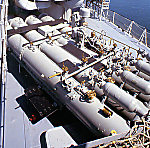
|
|
|
|

|
Ahead-Throwing Anti-Submarine Weapons
|
|
|
"Hedgehog"
|
Fitted to
|
FLOWER class corvettes, River class
frigates, River class destroyers
|
|
Role
|
Ahead throwing ASW
projector
|
Barrels / Projectiles
|
24 projectiles for full mounting
|
Range
|
180m
|
Ammunition
|
Contact fused bombs (also with magnetic
proximity fuses) with 35 lbs of Torpex warhead.
|
Design Date
|
Early 1940s
|
Approximate Cdn. Service Dates
|
1943? to 1945
|
Comments
|
Hedgehog was the first ahead-throwing ASW
weapon to enter service with the RCN, and was a huge improvement over
conventional depth charges in that it allowed the attacking ship to
stand-off from the target and maintain sonar contact right up until the
time of firing the weapon. With conventional depth charges, the
attacking ship was forced to break sonar contact with the target in
order to approach and fire the weapons. The mounting could be adjusted
to point 15 degrees either side of the bow, and the bombs were angled
slightly
in the launcher in order to drop on the target in a spread pattern. The
contact fused bombs would only explode if they made contact with the
target (or the ocean bottom if shallow enough). The caps on the top of
the bombs covered the arming propellers (one can be seen uncovered in
Photo 4 below) which would turn in the water to arm the bomb. There
were also half-Hedgehog versions, with 12 projectiles each, which could
be installed port and starboard on ships where it was desired to retain
a gun mounting.
|
Sources
|
Naval
Weapons of the World website.
Macpherson, Ken and Milner, Marc. (1993). Corvettes of the Royal
Canadian
Navy 1939-1945. Vanwell Publishing Ltd. St. Catherines, ON.
|
Photos 1-4: © Sandy McClearn
|
1. On SACKVILLE.
|
2. On SACKVILLE. |
3. On SACKVILLE. |
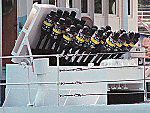
|
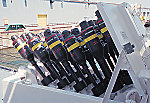
|
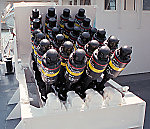
|
| 4.
On SACKVILLE. |
5.
|
6.
|
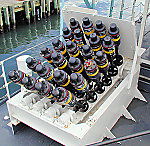
|
|
|
|
|
Mk.4
"Squid"
|
Fitted to
|
CASTLE class corvettes, PRESTONIAN class
frigates, Tribal class destroyers
|
|
Role
|
Ahead throwing ASW
mortar |
Barrels / Projectiles
|
3
|
Range
|
250m
|
Ammunition
|
Hydrostatically fused depth bombs with
200 lb. warhead.
|
Design Date
|
1943
|
Approximate Cdn. Service Dates
|
1944 - 1967
|
Comments
|
Second generation ahead-throwing ASW
weapon to see RCN service, this triple short-barrelled mortar was an
improvement over the previous Hedgehog, although the RCN was slow to
adopt this weapon during the war, and it only saw service in the twelve
CASTLE class corvettes before 1950.
The mounting could be rotated
through 90 degrees for loading (see photos 4 and 5), and the mounting
was usually
accompanied by a short track that supported the loading cart (photos 1
and 5). The
barrels were angled slightly apart (see photos 1 and 6) to drop the
bombs on the target in a
triangular pattern, designed to crush the submarine's pressure hull.
The weapon was closely integrated with the Type 144 (and later Type
164) sonars to control firing. Because the bombs were hydrostatically
fused, rather than contact fused like the previous Hedgehog weapon,
they would explode every time rather than only when they hit the
target.
CASTLE class corvettes mounted a single Squid forward of the bridge,
while later ships carried two mountings.on the quarterdeck. On HAIDA
(see photos 7 and 8), the mortar ammunition handling room was in the
deckhouse just forward of the Squid mountings. This is where the
ammunition was hoisted up from the magazine (situated in the bowels of
the ship below the wardroom), and the ready-use ammunition was stored.
|
Sources
|
Naval
Weapons of the World website.
Gough, Barry M. (2001). HMCS
HAIDA - Battle Ensign Flying. Vanwell Publishing Ltd. St.
Catharines, ON.
Macpherson, Ken and Milner, Marc. (1993). Corvettes of the Royal
Canadian
Navy 1939-1945. Vanwell Publishing Ltd. St. Catherines, ON.
Correspondence with M. Healey and N. Millen.
Canadian
War Museum
HMCS HAIDA
National Historic Site
|
Photo 1: © M.D. Thomas
Photos 2-8: ©
Sandy McClearn
|
1. On HMS CAVALIER.
|
2. At CWM.
|
3. At CWM.
|
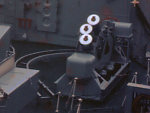
|

|
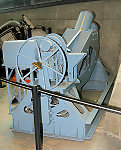
|
4.
On HAIDA.
|
5.
On HAIDA. |
6.
On HAIDA. |
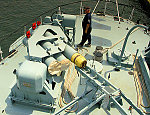
|

|
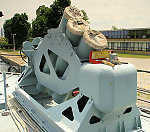
|
| 7.
On HAIDA. |
8.
On HAIDA. |
9.
|
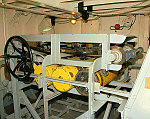
|
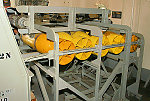
|
|
|
|
Mk.NC10
"Limbo"
|
Fitted to
|
ALGONQUIN, CRESCENT, and ST. LAURENT,
RESTIGOUCHE, MACKENZIE, ANNAPOLIS, and IROQUOIS class destroyers.
|
|
Role
|
Ahead throwing ASW
mortar |
Barrels / Projectiles
|
3
|
Range
|
Controllable, between 366 to 910m
|
Ammunition
|
Time fused bombs with 200 lb. warhead. |
Design Date
|
??
|
Approximate Cdn. Service Dates
|
1955 - early 1990s
|
Comments
|
Third and final generation of ASW mortar
to see Canadian service, this triple barrelled mortar had longer
barrels than Squid and was stabilized to provide greater accuracy.
Limbo mountings were aimed, and the depth fuses were set, by the SQS
502 and 505 sonars.
The Limbo launcher could be rotated parallel to the deck for storage
and loading, the latter of which was done through ports in the side of
the mortar well (see photo 1). Limbo was carried on the quarterdeck,
and all ships
(with the exception
of the ANNAPOLIS and IROQUOIS classes) were built (or modified in the
case of ALGONQUIN and CRESCENT) with two mountings (see photo 8 for a
detail photo of a model of HMCS MACKENZIE in the Canadian War Museum).
ST. LAURENT class
ships lost the forward mounting to make room for the new helicopter
hangar during the DDH refits, while Improved RESTIGOUCHE class ships
lost the forward mounting in favour of ASROC. |
Sources
|
Naval
Weapons of the World website.
Corvus Publishing Group / Canada's
Navy Annual. Various
Issues. (1985-1991)
Mike Potter's ST. LAURENT class weapons table
Correspondence with T. Fullerton, M. Healey, and N. Millen.
Canadian
War Museum
|
Photos 1,5,7&8: © Sandy
McClearn
Photo 2: © M.D. Thomas
Photos 3,4:
Courtesy Corvus Pub. Grp.
Photo 6:
© DND.
|
1. On HMS PLYMOUTH.
|
2. On HMS PLYMOUTH.
|
3. In storage / loading position.
|
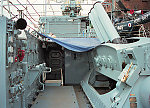
|
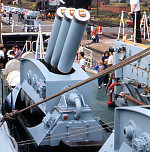
|
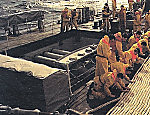
|
4.
Trained to starboard.
|
5.
Mortar handling room on PLYMOUTH.
|
6.
Twin mortars fore and aft.
|

|
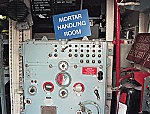
|
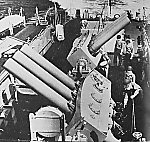
|
7.
Ammunition room on PLYMOUTH.
|
8.
Twin Limbo on model in CWM.
|
9.
|
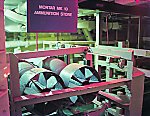
|

|
|
|

|
Anti-Surface Warfare and ASW Torpedoes
|
|
|
21"
surface torpedo launcher
|
Fitted to
|
River, Town, Tribal, V, and C class
destroyers,
UGANDA/QUEBEC, and ONTARIO.
|
|
Role
|
Torpedo launcher for 21"
ASuW torpedoes
|
Barrels / Projectiles
|
4 each launcher
|
Range
|
N/A, launched torpedoes over the side of
the ship at 90 degrees to the ship's course..
|
Ammunition
|
21" ASuW torpedoes and Mk.X depth charges
|
Design Date
|
??
|
Approximate Cdn. Service Dates
|
?? - 1966
|
Comments
|
Torpedo launcher for 21" diameter
torpedoes installed primarily on destroyers in the RCN, but also on the
cruisers UGANDA/QUEBEC and ONTARIO. River class destroyers were
originally fitted with two quad launchers, with the aft launcher later
removed to make room for new AA armament. Later destroyers were only
fitted with a single quad launcher, and HAIDA carried hers into
retirement.
The Town class destroyers in Canadian service, such as COLUMBIA (see
photo 5), carried the original USN type triple launchers.
|
Sources
|
Naval
Weapons of the World website.
Gough, Barry M. (2001). HMCS
HAIDA - Battle Ensign Flying. Vanwell Publishing Ltd. St.
Catharines, ON.
Correspondence with B. Lake.
HMCS HAIDA
National Historic Site
|
Photo 1: © M.D. Thomas
Photo 2: © DND / B.
Lake
Photos 3&4: ©
Sandy McClearn
Photo 5: ©
Charles Sadler, courtesy of John Sadler
|
1. On HAIDA.
|
2. On ONTARIO.
|
3. On HAIDA.
|

|
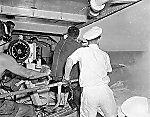
|
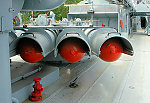
|
| 4.
On HAIDA. |
5.
USN type on COLUMBIA.
|
6.
|
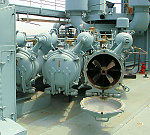
|
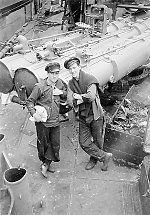
|
|
|
|
Mk.IX
|
Fitted to
|
River, Tribal, V, and C class destroyers,
UGANDA/QUEBEC, and ONTARIO. |
|
Role
|
ASuW torpedo
|
Propulsion
|
Radial diesel
|
Speed
|
36-41 knots (depending on version) |
Range
|
10-11,000 yards (depending on version) |
Warhead
|
Approx. 750 lbs of high explosive (TNT
and later Torpex), impact or magnetic influence exploders
|
Design Date
|
1928
|
Approximate Cdn. Service Dates
|
1931-1966
|
Comments
|
Primary surface-launched anti-surface
torpedo used by the RCN from 1931 until 1966, when this type of weapon
was retired from service. These weapons were a major part of pre-war
destroyer training, but saw little use with the RCN during the war.
|
Sources
|
Naval
Weapons of the World website.
Gough, Barry M. (2001). HMCS
HAIDA - Battle Ensign Flying. Vanwell Publishing Ltd. St.
Catharines, ON.
Correspondence with B. Lake.
|
Photo 1: © DND / B. Lake.
|
1. Retrieval of practice torp on ONTARIO.
|
2.
|
3.
|

|
|
|
|
|
|
Mk.37
ASW torpedo
|
Fitted to
|
OBERON class submarines
|
|
Role
|
"Lightweight" ASW torpedo
|
Diameter
|
19"
|
Versions Used
|
Mod 0, Mod 2, and Mk. NT37
|
Propulsion
|
Electric drive (Mod 0 and 2) or OTTO fuel
engine (NT37)
|
Range
|
9 to 21 km depending on version and speed
|
Speed
|
26 or 17 knots (respective to range) for
Mk.37; 36 knots for Mk.NT37.
|
Warhead
|
330 lbs Torpex
|
Design Date
|
1956
|
Approximate Cdn. Service Dates
|
1965 to late 1980s.
|
Comments
|
USN origin torpedoes used exclusively in
RCN service in OBERON class submarines. Mod 2 torpedoes were wire
guided, while the Mod 0 version was shorter, unguided (though still
with passive-active homing capability), and was used in the stern
countermeasure tubes. The new Mk.NT 37 version incorporated a new
powerplant, which increased speed and range. This torpedo unfortunately
did not work well with the RN practice of keeping warshots loaded and
flooded in the tubes at all times; the Mk.37 could only be kept flooded
for a few hours, and immersion rendered the torpedo useless for further
use as it could not be considered reliable.
The photos below show a Mk.37 torpedo being loaded in an OBERON class
submarine.
|
Sources
|
Naval
Weapons of the World website.
Perkins, J. David. (2000). The
Canadian Submarine Service in Review. Vanwell Publishing Ltd.
St.
Catharines, ON.
|
Photos 1-3: Courtesy Corvus Pub.
Grp.
Photos 4&5:
|
1.
|
2.
|
3.
|

|
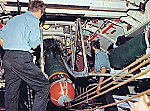
|
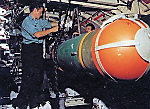
|
4.
|
5.
|
6.
|
|
|
|
|
|
Mk.48
torpedo
|
Fitted to
|
OBERON and VICTORIA class submarines
|
|
Role
|
"Heavyweight" ASW and
ASuW
torpedo
|
| Diameter |
21 inches
|
Versions Used
|
Mod 4 and possibly ADCAP
|
Propulsion
|
External combustion gas piston engine
|
Range
|
9 km?
|
Speed
|
55 to 63 knots approx.
|
Warhead
|
1,200 lb. TNT equivalent
|
Design Date
|
1970
|
Approximate Cdn. Service Dates
|
Late 1980s.
|
Comments
|
Replaced the Mk.37 torpedo in Canadian
service in OBERON class submarines, and the new VICTORIA class
submarines are being refurbished to carry this weapon. Existing
torpedoes may be upgraded to the ADCAP standard for use on the newer
submarine class.
|
Sources
|
Naval
Weapons of the World website.
Perkins, J. David. (2000). The
Canadian Submarine Service in Review. Vanwell Publishing Ltd.
St.
Catharines, ON.
|
Photos
|
1.
|
2.
|
3.
|
|
|
|
|
|
Thrower
Mk.4
|
Fitted to
|
CRESCENT, ALGONQUIN, and ST. LAURENT,
RESTIGOUCHE, MACKENZIE, and ANNAPOLIS class destroyers.
|
|
Role
|
Torpedo thrower
|
Projectiles
|
Mk.44 or Mk.46 torpedoes
|
Range
|
Launched torpedoes over the side of the
ship.
|
Design Date
|
1916 for Mk.II; ~1940 for Mk.IV |
Approximate Cdn. Service Dates
|
1955 to 1980s?
|
Comments
|
Former depth charge thrower converted for
use launching lightweight ASW torpedoes over the side of destroyers.
Replaced in service by the Mk.32 triple torpedo launcher. Photo 1 shows
this type of launcher as depicted on a model of HMCS MACKENZIE in the
Canadian War Museum; it was mounted adjacent to the after-most
deckhouse on these ships. The cradle was permanently attached to the
launcher, and only the torpedo was thrown clear of the ship. The cradle
was angled to ensure that the torpedo entered the water nose first.
|
Sources
|
Naval
Weapons of the World website.
Gough, Barry M. (2001). HMCS
HAIDA - Battle Ensign Flying. Vanwell Publishing Ltd. St.
Catharines, ON.
Macpherson, Ken and Milner, Marc. (1993). Corvettes of the Royal
Canadian
Navy 1939-1945. Vanwell Publishing Ltd. St. Catherines, ON.
Barrie, Ron and Macpherson, Ken. (1996). Cadillac of
Destroyers: HMCS ST. LAURENT and Her Successors. Vanwell Publishing
Ltd. St. Catherines, Ont.
Mike Potter's ST. LAURENT class weapons table
Canadian
War Museum
|
Photo 1: © Sandy McClearn
|
1. On model in CWM..
|
2.
|
3.
|
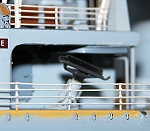
|
|
|
|
|
Mk.32
torpedo launcher
|
Fitted to
|
ST. LAURENT, RESTIGOUCHE, MACKENZIE,
ANNAPOLIS, and IROQUOIS class destroyers, and HALIFAX class frigates.
|
|
Role
|
Launcher for
"lightweight" ASW torpedoes
|
Projectiles
|
Mk.44 or Mk.46 torpedoes |
Range
|
Launched torpedoes over the side of the
ship. |
Design Date
|
??
|
Approximate Cdn. Service Dates
|
Early 1970s to present
|
Comments
|
Available as a trainable triple launcher
(as installed on IROQUOIS class ships) or as a fixed twin launcher
installed in the forward corners of the hangar structure on HALIFAX
class ships. The former must be reloaded in the open, while the latter
can be reloaded from inside the ship. Installed on IROQUOIS class ships
as built, the triple launcher was retrofitted to the older destroyers
later on.
|
Sources
|
Naval
Weapons of the World website.
Barrie, Ron and Macpherson, Ken. (1996). Cadillac of
Destroyers: HMCS ST. LAURENT and Her Successors. Vanwell Publishing
Ltd. St. Catherines, Ont.
Canadian
War Museum
|
Photos 1-3: © Sandy McClearn
Photo 4: © DND / CWM. |
1.
|
2. On IROQUOIS class.
|
3. On HALIFAX class.
|
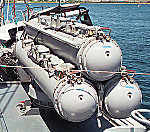
|
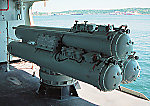
|

|
4.
Launching torpedo.
|
5.
|
6.
|
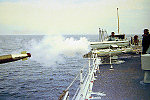
|
|
|
|
|
Mk.44
ASW torpedo
|
Fitted to
|
ST. LAURENT, RESTIGOUCHE, MACKENZIE,
ANNAPOLIS, and IROQUOIS class destroyers ?? |
|
Role
|
Lightweight ASW torpedo
|
| Diameter |
12.75"
|
Propulsion
|
Seawater battery
|
Range
|
5 km
|
Speed
|
30 knots
|
Warhead
|
75 lbs Torpex
|
Design Date
|
1952
|
Approximate Cdn. Service Dates
|
??
|
Comments
|
Former standard NATO lightweight ASW
torpedo for use from surface ships. Also used with ASROC.
Replaced by Mk.46.
|
Sources
|
Naval
Weapons of the World website.
|
Photos
|
1.
|
2.
|
3.
|
|
|
|
|
|
Mk.46
ASW torpedo
|
Fitted to
|
ST. LAURENT, RESTIGOUCHE, MACKENZIE,
ANNAPOLIS, and IROQUOIS class destroyers, HALIFAX class frigates. |
|
Role
|
Lightweight ASW torpedo
|
| Diameter |
12.75"
|
Propulsion
|
OTTO fuelled reciprocating external
combustion engine
|
Range
|
7 km
|
Speed
|
28+ knots
|
Warhead
|
98 lbs PBXN-103
|
Design Date
|
1964
|
Approximate Cdn. Service Dates
|
?? to present
|
Comments
|
Current standard NATO lightweight ASW
torpedo for use from surface ships and aircraft. Also intended for use
with ASROC. Note contra-rotating propellers in Photo 1, and the
parachute at the tail of the torpedo in Photo 2.
|
Sources
|
Naval
Weapons of the World website.
Barrie, Ron and Macpherson, Ken. (1996). Cadillac of
Destroyers: HMCS ST. LAURENT and Her Successors. Vanwell Publishing
Ltd. St. Catherines, Ont.
|
Photos 1-2: © Sandy McClearn
|
1. Shipboard training torpedo.
|
2. Helicopter dropped version.
|
3.
|
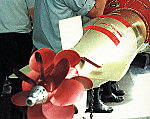 |
 |
|
|
|

Additional Sources:
Barrie, Ron and Macpherson, Ken. (1996). Cadillac of
Destroyers: HMCS ST. LAURENT and Her Successors.
Vanwell Publishing Ltd. St. Catherines, Ont.
Steed, Roger G. (1999). Canadian Warships Since 1956.
Vanwell Publishing Ltd. St. Catherines, ON.
Jane's Fighting Ships, Various Editions
Conway's All The World's Fighting Ships, Various Editions
Corvus Publishing Group / Canada's Navy Annual. Various
Issues. (1985-1991)
With information from the files of Mike Potter.
Correspondence with B. Lake.
Photos from M.D. Thomas.
|
